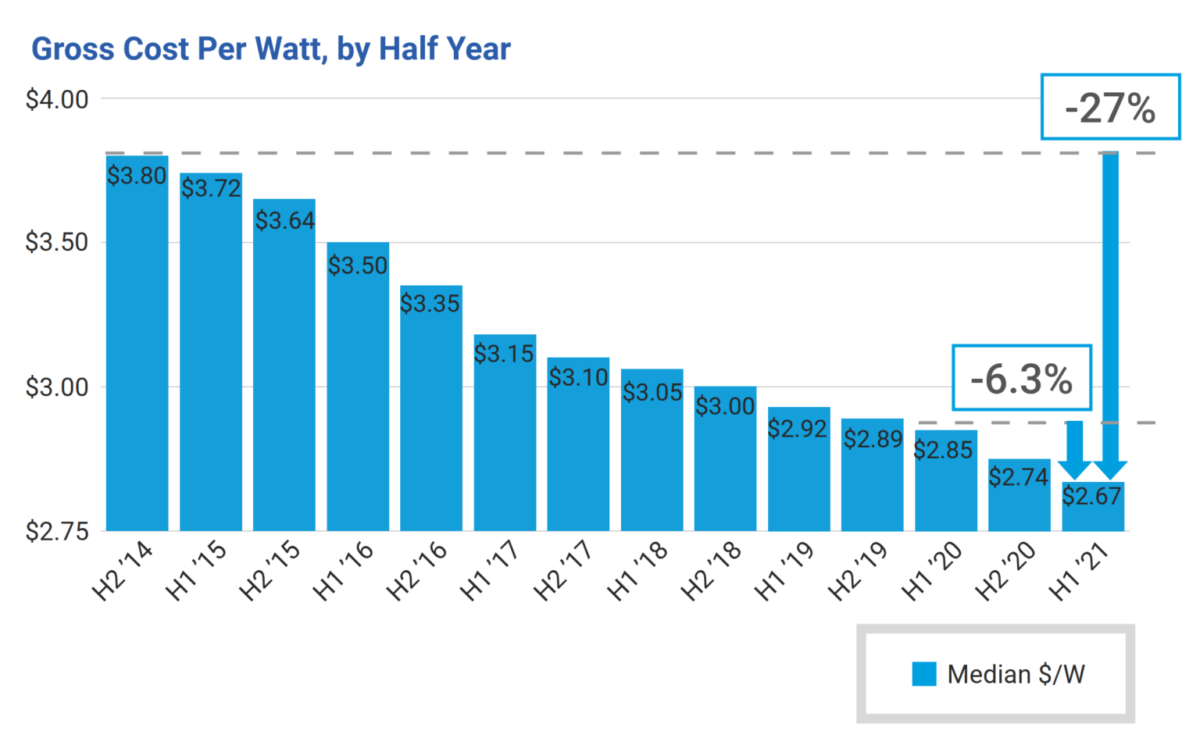From pv magazine USA
EnergySage has released its thirteenth Solar Marketplace Intel Report, in which the company shows that customers were quoted 27% lower prices in the first half of 2021 versus 2014, and that residential solar pricing has fallen 6.3% since July 2020.
This acceleration – starting in July 2020, and ending before July of this year – is compared to the slower price declines EnergySage saw starting in the first half of 2017, and ending in the first half of 2020.
The data shows a broad distribution of pricing, however, and a single national price average doesn’t do it justice. While the median price quoted was $2.67 per watt, greater than 25% of all quotes were $2.25/watt. The long tail of pricing going upward beyond $4.00/watt balanced out the heavy volumes of quotes below the national average.
That fact that so much capacity is being quoted below $2.25/watt is probably worthy of research, so we can better understand the pricing possibilities of the U.S. residential solar market.

Oddly, the nation’s most expensive state, Colorado, at $3.15/watt, is a neighbor of the cheapest state, Arizona, at $2.25/watt.
Notably, while the price has fallen by 6.3% since last year, the average payback time for a similarly sized 10.2 kWdc project has actually increased – from 8.5 to 8.8 years.
A few hypotheses on what’s behind the increased average payback time:
Popular content
- States with fewer incentives have been installing more
- Incentives are falling overall
- Installations on less productive rooftops have become more feasible due to lower prices
- An increase in quick finance tools, which cost a bit more than cash/bank loan purchases
- A desire for energy resilience versus pure savings or environmentalism

Energy storage pricing is mixed, and on average it went up across the nation. However, in key markets like Florida, California, and Texas, pricing is down. Furthermore, we’re seeing Enphase take an increasingly larger share of the home storage market, passing by Tesla to become the No. 1 supplier.
Interestingly, Enphase is tied with Sonnen as the most expensive home battery product tracked, at roughly 50% more than Tesla’s Powerwall. Enphase’s product success probably has something to do with the increase in energy storage pricing overall.
This nuance in pricing is also potentially indicative of why people are buying batteries – as a backup power source. The second most important reason is to save cash on their electricity bills.
We shouldn’t be surprised that a large number of people have been buying storage for resilience purposes. Generac, a new entrant to the solar+storage industry, has sold plenty of home generators, which saved consumers nothing on their electricity bills. A generator’s payback is measured in units of comfort: air-conditioning, lights, and frozen foods.
While EnergySage has found that customers have always had an interest in energy storage, there is a strong variance in this interest based on geographic location. Many of the states seeking storage are in the central region of the nation, and in places without policies as supportive of solar. Regions that have suffered recent power grid failures have shown a strong energy storage preference as well.
EnergySage says that its data shows clear shifts toward greater demand for energy storage, which remained persistent throughout the past five months, following the Texas power grid failure in February of this year.
This content is protected by copyright and may not be reused. If you want to cooperate with us and would like to reuse some of our content, please contact: editors@pv-magazine.com.


By submitting this form you agree to pv magazine using your data for the purposes of publishing your comment.
Your personal data will only be disclosed or otherwise transmitted to third parties for the purposes of spam filtering or if this is necessary for technical maintenance of the website. Any other transfer to third parties will not take place unless this is justified on the basis of applicable data protection regulations or if pv magazine is legally obliged to do so.
You may revoke this consent at any time with effect for the future, in which case your personal data will be deleted immediately. Otherwise, your data will be deleted if pv magazine has processed your request or the purpose of data storage is fulfilled.
Further information on data privacy can be found in our Data Protection Policy.